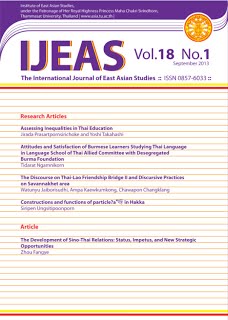Constructions and Functions of Particle ʔa4呀 in Hakka
Keywords:
Hakka, grammatical particle, post-verbal particleAbstract
In most languages, the most common particle is the sentence-f inal particle. However the Hakka language, apart from the sentence- f inal particle, there are also post-verbal particles ans this makes the word class diff icult to identify. The particle has no precise meaning itself but has an important function at clause or phrase level.
The goal of this study was to clarify the particle ʔa4呀 in Hakka language. When the author investigated grammar of Bangkok Hakka, The particle ʔa4呀 was found to have multiple functions. The particle ʔa4呀 is a bound morpheme. It cannot stand alone and always attaches to the post-verbal position. Some constructions can delete it but others cannot. Data from colloquial language found in the texts were collected and analyzed. Research f indings indicate that there are at least three patterns of use for particle ʔa4呀, according to its function. i) it should be called location particle and its structure is V + particle ʔa4呀+ locative phrase. ii) it may be called as aspect marker and its structure is V+ particle ʔa4呀+ PERF. iii) it is used in the interrogative clause and its structure is V+ particle ʔa4呀+ alternative conjunction + Item. Furthermore, the particle ʔa4呀 can be deleted in the structure V± particle ʔa4呀+ direction but the sound does not appear so elegant.



